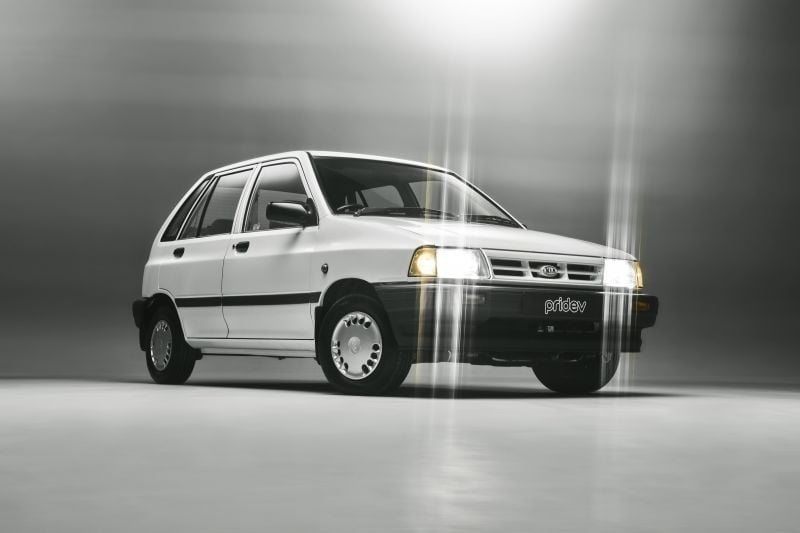Kia has celebrated its 80th anniversary with an electric restomod of one of its longest-running vehicles.
The Kia Pride was a Korean-built version of the Mazda 121 which was produced from 1987 to 2000; it was sold here by Ford as the first-generation Festiva.
The Pride EV is the work of British EV powertrain and conversion specialist Electrogenic, in partnership with Kia UK.
Kia’s original Pride is significant in that market as it was the Korean brand’s first model there in 1991.
100s of new car deals are available through CarExpert right now. Get the experts on your side and score a great deal. Browse now.
The road-legal restomod is based on a 1996 Pride 1.3 LX from Kia UK’s heritage fleet, and as with other manufacturer-sponsored retromods like Nissan’s Bluebird-based Newbird and Hyundai’s Grandeur Heritage Series, it doesn’t preview a production vehicle.
While the petrol engine has been replaced with an electric motor and a battery, the Pride EV retains its original five-speed manual transmission.
This is unusual for an EV, though other companies like Jeep have revealed similar concepts.
Kia says the Pride EV is intended to be “as engaging to drive as an early hot hatch”, and weighs only 20kg more than the vehicle it’s based on despite the addition of a pair of 10kWh battery packs – one under the bonnet, one below the boot floor.
Electrogenic laser-scanned the vehicle and CAD modelled the battery and control systems, before removing the engine, fuel tank, fuel lines and filler neck, and installing the battery packs, electric motor, and a charging socket beneath the filler flap.
The Pride EV features a 3.3kW onboard charger.
The five-speed manual is matched with a “performance-oriented” clutch kit, while the throttle pedal’s mechanical linkage has made way for a drive-by-wire setup.
Here’s how the Pride and Pride EV compare:
| Kia Pride 1.3 LX | Kia Pride EV | |
|---|---|---|
| Weight | 850kg | 870kg |
| Power | 45kW at 5500rpm | 45kW (Eco) 80kW at 3600-4800rpm (Sport) 60kW (Auto) |
| Torque | 118Nm at 3500rpm | 118Nm (Eco) 234Nm at 0-2500rpm (Sport) 176Nm (Auto) |
| 0-100km/h | 11.8 seconds | 8 seconds (estimated; Sport mode) |
Kia UK claims the Pride EV has 196km of range “when driven sensibly in Eco mode”, and this figure will “fall somewhat” in Sport mode.
Regenerative braking is minimal in those modes, but more akin to modern EVs in Auto mode. This is activated by pushing the clutch pedal, shifting the gear lever into third, and then pushing the drive mode switch to Auto.
Despite the huge overhaul under the skin, the Pride EV is almost identical to the donor vehicle. That includes the original 12-inch steel wheels with covers, and the analogue instrument cluster.
Look closely, however, and you can see some changes like lime green brake calipers, upgraded lights front and rear and lime green piping for the era-appropriate grey cloth upholstered seats.
The analogue fuel level dial remains, but now shows the battery’s current state of charge.
Kia UK says the original structure, as with all Electrogenic conversions, has been entirely preserved and all modifications are entirely reversible.
The Pride was an important vehicle for Kia.
While the first-generation Ford Festiva, as it was badged here, was replaced in Australia in 1994 by a rebadged Kia Avella, the original lived on in other markets.
For example, Iranian firm SAIPA built the Pride under licence well into the 2000s.
First conceived by Mazda as a hatchback, Kia and SAIPA ended up building sedan, wagon, ute and van versions.
Kia is celebrating its 80th anniversary this year, but it isn’t celebrating 80 years of building cars.
It was founded in 1944 as Kyungsung Precision Industry, a bicycle components manufacturer.
It was renamed Kia Industries in 1952 and shifted to producing bicycles, not producing a motorised vehicle until 1962 with the three-wheeled K-360 light truck.
The company’s first passenger car was the Brisa in 1974, based on the Mazda Familia. This was built until 1981 when military dictator Chun Doo-hwan forced Kia to end passenger car production and focus entirely on light trucks.
It restarted volume passenger car production in 1987 in collaboration with Ford, with the Pride being its first vehicle. It was exported widely, including not only to the UK and Australia but also the US (as the Ford Festiva) and to Europe.










